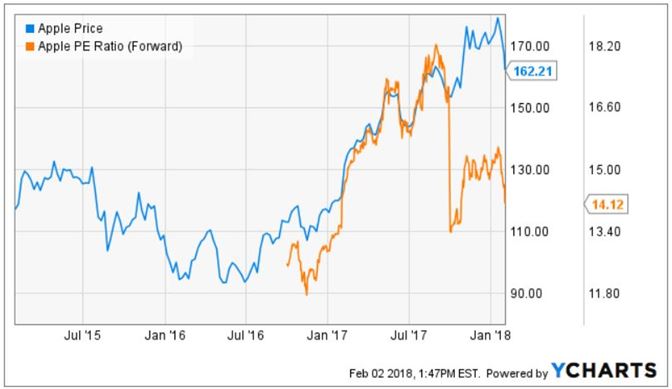Let's say you had a company that delivered blockbuster products which it sold for the largest margins in the industry and delivered record profits.
Let's also say that it committed spending $280 billion to share buy backs and dividend payouts.
Let's also toss in the fact that this magical company sells at a discount to the rest of the players in the industry, but also to the entire market as a whole.
You would think that such a robust firm would leap 10% on its latest earnings announcement.
But if that was your expectation you'd be wrong. In fact, the shares of Apple (AAPL) plunged by 10%.
Stock markets are recalcitrant, impetuous beasts, and last week was no different. What we got was the tax loss selling I had been predicting for months, it just arrived four weeks late.
The proof is in how ALL stocks fell, not just Apple's. Earnings were irrelevant.
It's painfully obvious that Apple's capricious price action is a result of not being the Amazon (AMZN) growth story that is held up as the poster boy for tech out-performance.
The lead up to the Q4 2017 earnings report served as a minefield for Apple shareholders as a slew of bleak reports about iPhone supply cuts, analyst downgrades, and weak iPhone X demand dominated the rhetoric leading up to the report.
The most outlandish report was published by The Nikkei Asian Review claiming Apple would slash its iPhone X production from 40 million to 20 million units.
The veracity of these reports was never verified.
As investors violently sold the rumors from $180 leading up to earnings, the expectations were diabolically low.
The only scenario in which Apple would disappoint, would be the implosion of key metrics.
The vital takeaways in Q4 were the all-important iPhone ASP (Average Selling Price) which topped estimates at $795 per unit surpassing the expected $755 by a healthy $40 margin.
The increase in ASP indicates that Apple sold a healthy mix of their higher premium iPhones; iPhone X, iPhone 8 and iPhone 8 plus. Analysts punished Apple for selling 3 premium smartphones instead of the customary two, which muddied the sales data and confused analysts to no end.
Ironically enough Facebook (FB), which announced earnings earlier in the day, told the identical story of higher prices per ad and lower ad units. But investors duly rewarded Facebook for focusing on higher quality and were more than happy to pay the extra premium.
It's clear that Apple analysts are on a witch hunt, and their herd mentality exacerbates negative investor sentiment.
A total revenue beat of $88.3 billion represented an increase of 13% YOY. iPhone unit sales missed marginally at 77.3 million units from an expected 80 million units.
However, the minuscule 1% drop was made up by the higher ASP verified by the revenue beat.
Apple's tax rate was 25.5% before the new tax bill was passed. The new tax rate going forward will be 15%, creating a massive windfall.
Luca Maestri, Apple's CFO, stated that Apple plans to reduce its cash balance to "approximately zero," meaning that the $285.1 billion in cash reserves will be put to use in the form of dividends and buy backs.
Other metrics that had the potential to spoil the earnings report included expected forward guidance, and even though the street were expecting $65 billion, $60-62 billion was seen as already baked into the price. Anything below that would be worrisome.
Apple announced just that, going forward with $60-62 billion in revenue guidance and no wonder Apple was up 3.4% after market directly following the earnings report.
The last significant commentary in the company call was information about iPhone X demand. Analyst after analyst asked a belabored Tim Cook the same question, and he repeatedly noted that Apple does not disclose specific iPhone model sales.
However, Cook did say "If you look at 8 Plus in particular to provide a little color there, it has gotten off to the fastest start of any Plus model. That for us was a bit of a surprise, and a positive surprise at that."
Tim Cook's commentary implicitly made out that Apple had great demand for its expensive smartphones and the overall ASP vindicates this strategy because the potent numbers show customers are meaningfully upgrading to newer and more expensive iPhones.
Keep in mind that many iPhone users abroad also pay for their iPhone per monthly installments, pushing up the raw ASP.
It was shocking that analysts repeatedly asked the same question about the iPhone X demand. Apple is not just an iPhone X company. Apple has an incredibly powerful ecosystem.
Its iOS 11 operating system is the natural choice with which to integrate all Apple products, and this ecosystem is incredibly sticky. If you are running a small business, as I am, having a range of different devices connected with each other is incredibly useful.
Another important point overlooked by Wall Street was Apple's service businesses that is accelerating. This includes Apple Music, iCloud, the Apple store, and the soon to be HomePod. Apple Music subscriptions were up an amazing 75% YOY. Conversion rates are the highest since the launch of the service more than a decade ago.
Tim Cook delved into the service side of the business and characterized the performance as a "phenomenal quarter on iPad, on the Mac, on Services, on Apple Watch, and on iPhones. I mean we're literally, we're firing on all cylinders."
Going forward, Apple will emphasize the service income streams, and this should command a higher multiple for the entire company, especially if it reaches 20-25% of gross revenue. The growth rate for Apple services in the current quarter was strong at 24%.
The Apple store set an all-time record. The iCloud is a service that continues to advance at "strong double digits," and has already become the size of a Fortune 100 company on a stand-alone basis.
The service side of the business revenue was $8.5 billion and looks to substantially outperform in 2018. The margins are growing nicely in this segment and across all service offerings. The number of paid subscriptions reached over 210 million at the end of the September quarter, an increase of 25 million in the last 90 days.
Apple profit margins came in at 37.9%, slimmer than the 38.9 percent expected. This is staggering for a smartphone company of this size. Most consumer electronic product companies see margins quickly erode due to fierce competition. The margin guidance of between 38%-38.5% remains sturdy and shows Apple's ability to sell premium products.
The last potential hiccup were the China numbers, and Apple was vindicated when it proved that rumblings of weakness were unsubstantiated. Apple returned to brisk growth in the China region growing at strong double-digits at 12%.
To say investors are confused over what to do about Apple shares is an understatement. On one hand, bears point out at the lack of innovation and revolutionary products that dazzle the investor community.
However, the bulls point to the double-digit revenue growth that gives the stock its foundations, along with returning capital to shareholders in the form of dividends and buybacks.
The bottom line is that apple announced no disastrous news, and with the ultra-low expectations coming into the earnings report, is a strong buy amid the backdrop of healthy global economic expansion.
Apple has huge margins for a consumer electronic goods company and the enormous cash flow means Apple has many levers they can pull in the capital structure scheme of things.
The stock is extremely cheap at 14X forward PE. By the way, the multiple has dropped a full point and a half in the last two weeks, which should entice institutional investors to dive in.
It's true that Apple sells an expensive smartphone and the prices are not for the faint of heart. However, this is completely justified by the quality of the product, which costs about $400-500 to produce. Quality products command higher prices period and it's a testament to Apple's creations that consumers are still willing to cough up the cash.
Buy low, sell high, it sounds like a winning business strategy to me.
What to do about Apple? The answer is to buy it with both hands once this indiscriminate market correction runs its course. I am sticking to my 2018 target of $200 a share.
To learn more about this extraordinary company please visit their website by clicking here.




